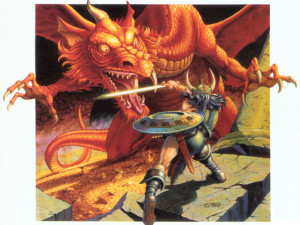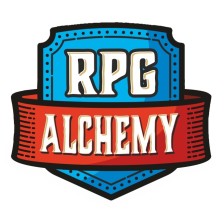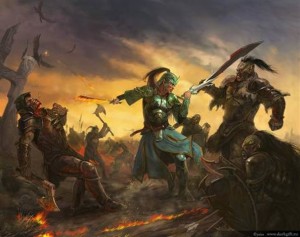Our group has been playing 5th edition now for a few months and one of the things I’m most happy about with this version of the game is how fast combat moves. I enjoyed running both 3rd and 4th edition but I was never completely satisfied with how long it took to run a combat encounter. Even after making a few house rules and tweaks combat seemed to take forever, especially at higher levels. I think there are several contributing factors to 5th edition’s increased combat speed. Some of these factors are core rules, others optional rules from the DMG, but all of these elements work together to make combat quicker and more exciting.
Action Economy
This is the single biggest change contributing to the pace of combat in 5th edition. In the past couple of editions I saw players agonize��over deciding what actions to take and trying to maximize getting in all of their allowed actions. In this edition characters��get one action on their turn. A player only needs to decide what one thing they want their character to do, even movement isn’t really an action, your character can simply move up to their speed during your turn. Any potential extra actions are covered by the bonus action. The two great things about bonus actions are, not everyone has bonus actions and know matter how many your character might have access to you can only take one per turn. One of my players has access to multiple bonus actions while another player has none at all. Watching this in action I’ve already seen the impact on combat speed, when a player’s turn comes up they act, quickly and decisively. Not only does this speed up the players’ turns but things move quicker on the DM’s side of the screen as well.
Combining with this is the streamlined number of basic actions available to every character and creature. These ten actions do a great job of covering virtually anything a player might what their character to do on their turn. Each action is different enough that I really haven’t seen the players spend much time considering which action to perform. By the time I tell a player it’s their turn they usually know exactly what they want to do; describe what they are doing, maybe roll a die, next up. I’d say the average player at our table is taking well under a minute to perform their entire turn, this is considerably less than the 3 – 5 minutes (or more!) taken in 3rd and 4th edition. This has an exponential effect on the game, turns that take less than a minute means rounds that take 5 to 6 minutes and combats that take around 15 to 20 minutes. That’s a lot quicker than previous editions.
Consistent Math
Another little difference in 5th edition is the lack of the “math” that occurs during the course of a character’s turn. In previous editions the math changed all the time depending on circumstances; move into a flanking position, add a bonus, take multiple attacks, decrease the hit bonus with each attack, make an off-hand attack, subtract a penalty, etc. Calculations during the players turn could become relatively complex and tended to fluctuate with every action. This isn’t the case in this version of the game. If you’re +6 to hit with your longsword you’re always +6 to hit with it; multiple attacks, +6 with each, attacking a target in cover, +6 to attack, attacking a hidden target, +6 to hit. Once the math has been done on your character sheet you know what your total modifier is regardless of situation, although some circumstance might impose advantage or disadvantage.
Advantage & Disadvantage
I wrote an entire article a few months ago about the advantage and disadvantage mechanic in 5th edition and its impact on the game. After using it for the past few months I’ve become an even bigger fan of the system. There was a time when I couldn’t image a game system without a comprehensive list of things that could give you a variety of minor bonuses and penalties, but��these days I feel about “modifiers” the same way I do about THAC0, a quaint, antiquated throwback to earlier editions. The advantage and disadvantage system greatly speeds up combat, no last second calculations (see above), no agonizing over doing exactly the “right” thing to maximize bonuses, and no ret-con descriptions, “Wait, I forgot about bless, I did hit the zombie!” Instead of nickel and diming a dozen factors you can simply look at the “big picture” of a character’s action and ask if there are enough elements present to grant a significant advantage (or disadvantage) to the action. Hell, even if you forget to factor it in��you can still just roll a second die and move on, no need to recalculate anything.

Lower Enemy Armor Class
In addition to the more consistent math the numbers in 5th edition tend to be “smaller”, especially in regard to AC. If you’ve had the chance to look around the new Monster Manual you’ll see what I’m talking about. Very few monsters have an AC over, or even near, 20. This means that even a 1st level character can hit virtually everything in the game; of course hitting a creature and doing any significant damage are two different things! I have noticed that this too speeds up combat by eliminating the frustration of not being able to hit and the player trying to figure out what to do. I often encountered this in earlier editions. When players feel like they are “moving forward” they tend to act quicker and the entire game speeds up.
Initiative Option
One of the last elements that I am using in my game comes right from the Dungeon Master’s Guide on alternative initiative options. In our game I use “side” initiative. Either the heroes or the bad guys go first (depending on circumstances) and then we alternate sides. When it’s the heroes’ turn the players decide what order they will act in, I do the same when it’s the bad guys’ turn. If an effect lasts “until the end of your next turn”, it lasts until the end of your side’s next turn. This alternate rule has kicked things into high-gear at our table and has allowed the players to more effectively execute their plans and actions (of course the same applies to the bad guys but I don’t think they’ve noticed!).
For those of you playing 5th edition none of this comes as any surprise, you’ve probably already seen the impact at your table. For those of you that haven’t played and are��playing older editions or something like Pathfinder, you might want to check out this system in action. I noticed the increase in combat speed during the first session, and that was while we were still getting our heads around the new mechanics!


Even though things flow quicker, I don’t feel like I am constrained any more than I was in previous editions. Like you mentioned, not having to try and get in ALL of my super-moves into the combat (a la 4e) and then immediately rest after combat is nice. Choosing your action is usually quick, the math is quick, and you move on. I also like that the game is deadlier at the early levels. That also gets things moving quicker too.
Samuel Van Der Wall recently posted…This Week In Roleplaying – December 19th, 2014
The optional initiative rule I mentioned also really speeds things up, more than you might think. When I tell the players it’s their turn they all spring into action. This past game night the players were taking around 5 minutes or so for their turn; that’s 5 minutes for all of them to go, not 5 minutes per player!
John Lewis recently posted…This Week In Roleplaying – December 19th, 2014
I want to like the alternate Initiative rules from the DMG, but my sticking point is how would you handle a Barbarian PC? Does the entire party benefit from the 7th level barbarian class feature that gives Advantage on initiative, which seems slightly over-powered, or does the barbarian loose that distinctive class features, which seems punitive for the player?
My biggest disappointment with the 5E DMG is that many of the options they present don’t provide guidance on how to handle conflicts like this one, between a class feature they baked into the base rules and the optional rule they suggest.
Zack Schwartz recently posted…Manifold Regards – Adapting Apocalypse World “Love Letters” for Numenera (or any system, really…)
Zack:
After looking at the DMG and the rest of the 5E material (thus far) I think that WotC has intentionally left some “looseness” in their rules, especially alternate rules. A big complaint gamers had with 4E was that the system was to rigid and that DM’s were less able to make tweeks and adjustments. The new rules are designed with these things in mind and some of the alternate rules require it (like the one you mention).
I feel like alternate rules are ones that “might” work for you but you have to look at how they’ll impact your specific group. The rule issue you mention for example, might not have any impact on a group lacking a barbarian. I look at the optional rules like “after-market parts”, they will probably work, more or less, but you’re going to have to make some adjustments and fine-tune them to your game.
John Lewis recently posted…This Week In Roleplaying – February 27th, 2015